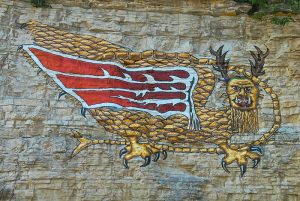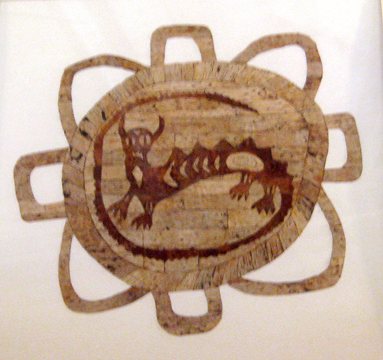Article Written by John Davis
Lost Treasure: The Piasa Bird

Ancient artists drew the largest creature of the Western Hemisphere on the face of a wall of limestone next to the wide and mighty Mississippi River. A speculative copy can be seen today sixteen miles north of present day St. Louis, Missouri, near Alton, Illinois.
The Piasa Bird, as it is called today, was first seen in 1673 by a traveler with writing skills when Father Jacques Marquette, explorer and Jesuit priest, wrote,
“While Skirting some rocks, which by Their height and length inspired awe, We saw upon one of them two painted monsters which at first made Us afraid, and upon Which the boldest savages dare not Long rest their eyes. They are as large As a calf; they have Horns on their heads Like those of a deer, a horrible look, red eyes, a beard Like a tiger’s, a face somewhat like a man’s, a body Covered with scales, and so Long A tail that it winds all around the Body, passing above the head and going back between the legs, ending in a Fish’s tail. Green, red, and black are the three Colors composing the Picture. Moreover, these 2 monsters are so well painted that we cannot believe that any savage is their author; for good painters in France would find it difficult to reach that place Conveniently to paint them. Here is approximately The shape of these monsters, As we have faithfully Copied It.”
The copy of the drawing made by Father Marquette is lost to history. Only the description remains. Yet what was this giant painting’s purpose? What did it reveal about whomever drew it? The Jesuit Relations, which were Marquette’s accounts sent back to Rome, offers us little in the way of expanded evidence. For that we must turn to archaeology.
Archaeologists have identified nothing to indicate it was a bird. The Piasa Bird story came from a fanciful professor of ancient languages at Shurtleff College, Alton, in 1836. His name was John Russell. He invented a wondrous tale of an Indian chieftain who lured the giant cliff dwelling Piasa bird to its doom after it developed a bloodthirsty habit of eating human flesh. In 1887, Russell admitted the whole story was made up, but locals love scary stories and the Piasa Bird tale endures to this day.

It seems archaeologists have discovered similar monsters described by tribes of northern regions near the Great Lakes.The Underwater Panther is spoken of in numerous native Americans’ tribal lore. The monster is said to have a beard like a lion, face human, and various descriptions which match that seen by Marquette on the giant bluff. Native weavings, wall and ground designs, and pottery indicate similar monsters much like the Piasa Bird, but without wings.
If you’ve read Father Marquette’s account above closely, you’ll notice there is no mention of wings at all. Modern scholars have identified the Underwater Panther as believed to be of primarily evil purpose. Ancient tales abound of how they surprise and pursue luckless voyagers, killing them. They guard realms from prying human ventures, equally with bloody methods. Not for nothing then were natives seen as living in great fear when they saw the hideous creature painted on the wall. Rifle shots in later centuries peppered the wall such that the well preserved monster Marquette saw was almost gone by the time another two centuries passed.
Sadly, during a time insensitive to cultural history, the original scene was quarried away because it was painted on sturdy limestone.
Today’s ‘copy’ of the Piasa Bird, the original of which was neither a bird, nor located on any land known as Piasa at the time (that only came later when settlers named the nearby creek), can be seen on a road which parallels the Mississippi River. A viewer gets some sense of the mighty, imposing size of it to men who for a thousand miles in either direction came through nothing but walls of trees on either side of the river. Speculation that this delineated an area of danger seems to prevail, and responses by those influenced by that fear were noted.
In the end, it is lost to us because fear, lack of interest, and cultural insensitivity have brought us to the imaginary beast depicted today, and the imaginary ‘legend’ associated with it.
~Written by MW Team Writer: John Davis
 John William Davis is a retired US Army counterintelligence officer and linguist. As a linguist, Mr. Davis learned five languages, the better to serve in his counterintelligence jobs during some 14 years overseas. He served in West Germany, Italy, and the Netherlands during the Cold War. There he was active in investigations directed against the Communist espionage services of the Soviet Union and Warsaw Pact. His mission was also to investigate terrorists such as the Red Army Faction in Germany, the Red Brigades in Italy, and the Combatant Communist Cells (in Belgium) among a host of others.
John William Davis is a retired US Army counterintelligence officer and linguist. As a linguist, Mr. Davis learned five languages, the better to serve in his counterintelligence jobs during some 14 years overseas. He served in West Germany, Italy, and the Netherlands during the Cold War. There he was active in investigations directed against the Communist espionage services of the Soviet Union and Warsaw Pact. His mission was also to investigate terrorists such as the Red Army Faction in Germany, the Red Brigades in Italy, and the Combatant Communist Cells (in Belgium) among a host of others.
His work during the Cold War and the bitter aftermath led him to write Rainy Street Stories, ‘Reflections on Secret Wars, Terrorism, and Espionage’. He wanted to talk about not only the events themselves, but also the moral and human aspects of the secret world as well.
Click to Read John’s Complete Profile

I’ve heard of the Underwater Panther before, but I didn’t realize it was more significant than just a single area legend.
I wonder if this was a legend that was born of a warning of a dangerous underwater current where people commonly were drowned. And if this particular place was one of those places.
Curious that the picture of Underwater Panther doesn’t have a fish tail as described by Father Marquette.